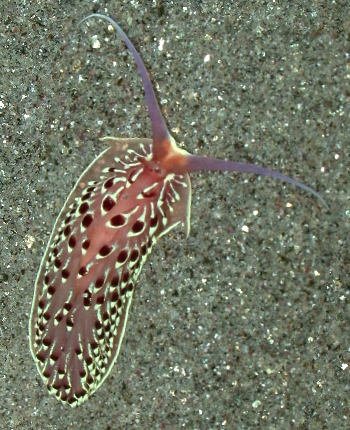
Cerberilla chavezi
Hermosillo & Valdes, 2007
Order: NUDIBRANCHIA
Suborder: AEOLIDINA
Family: Aeolidiidae
DISTRIBUTION
Known only from Bahia de Banderas and Manzanillo (Pacific coast of Mexico).
PHOTO
Locality: Manzanillo, 20 feet, Colima, Mexico, tropical eastern Pacific, 23 March 2004, Muddy bottom. Length: 18 mm. Photographer: Ali Hermosillo.
The body is typical of a species of Cerberilla, being relative wide, flattened and elongate, with the foot being about twice the width of the body. The anterior corners of the foot are extended into tentacular foot corners, and the oral tentacles are extremely long, almost two-thirds the body length. On the other hand the rhinophores, sitting close together in the midline, are very short. The cerata are arranged in angled rows. The ceratal shape varies in different parts of the body, the anterior ones being more swollen, flattened and club-shaped while the posterior ones are longer and more cylindrical.
The background color of the body is a translucent wine red, and appeaers darker in the centre of the body than at the edges, and on the foot. The edge of the foot is lined with a cream-yellow line. The oral tentacles are translucent purple with a pinkish base, and the rhinophores are translucent pinkish red with a cream tip. The cerata are translucent pinkish with an opaque cream yellow dorsal line running about halfway along each ceras where it is broken by a deep reddish brown patch just below the cream yellow tip.
Cerberilla chavezi grows to at least 19 mm long in length. It has been found crawling over or burrowing through sand.
-
Hermosillo A. & Valdés, A. 2007. Five new species of Aeolid nudibranchs (Mollusca, Opisthobranchia) from the Tropical Eastern Pacific. American Malacological Bulletin, 22: 119-137, 13 text figures, 1 color pl.
Rudman, W.B., 2007 (August 1) Cerberilla chavezi Hermosillo & Valdes, 2007. [In] Sea Slug Forum. Australian Museum, Sydney. Available from http://www.seaslugforum.net/factsheet/cerbchav
Related messages
-
Cerberilla chavezi - new aeolid from the eastern Pacific
From: Alicia Hermosillo, August 2, 2007
